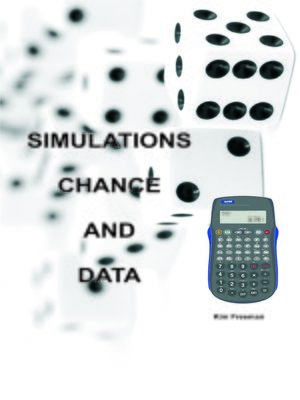
Sign up to save your library
With an OverDrive account, you can save your favorite libraries for at-a-glance information about availability. Find out more about OverDrive accounts.
Find this title in Libby, the library reading app by OverDrive.



Search for a digital library with this title
Title found at these libraries:
| Library Name | Distance |
|---|---|
| Loading... |
This is an excellent book for teachers to introduce a class to simulations, chance and data. It contains a number of simulation exercises for math classes. There are teacher notes as well as student handouts for each simulation.
Our exposure to data is increasing at an exponential rate and the use of simulations will soon become a core expertise and skill in helping to make decisions. Being able to analyse data, choose the best model for approximations and being aware of limitations will become increasingly more important skills.
The activities and investigations in this book help to develop and reinforce many of the basic concepts of probability. Simulations are often used when it is difficult to calculate the theoretical answer but most of the activities do come with the theory explained. After each simulation, students are guided toward the theoretical answer. While most activities get them to work independently they are encouraged to compare their answers with others. Teachers should be able to help with any analysis and with most of the activities teacher notes are included.
Students can use dice, coins or other tools to complete each simulation. Spreadsheets and computer programs can be used to quickly demonstrate central tendency which leads students to realise that using means from several smaller sets will vary more than using the mean of a large data set. Therefore both junior and senior students should realise that increasing the sample size will increase the reliability of the results.
At Years 9 and 10, students need to be able to describe the distribution of the trials and write what they think would be reasonable ranges from the trial data. The theoretical probabilities are quite often solved by using probability trees. To do this students will need to be able to use fractions and ratios. At year 11 students need to be able to design their own simulations and they are assessed on their ability to describe and simply analyse what has happened. At year 12 students need to carry out a 1 or 2 step simulation. They are assessed on their ability to describe and carry out the simulation and link their results to the theoretical probability.
The use of these simulations leads naturally to permutations, combinations, conditional probability and expected values. For senior classes there is also a natural progression to normal distribution and confidence interval work.







